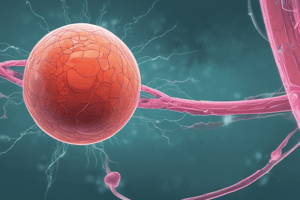Podcast
Questions and Answers
What is the primary reason for conducting a bone marrow examination in this patient with progressive pancytopenia?
What is the primary reason for conducting a bone marrow examination in this patient with progressive pancytopenia?
- To assess for any iron deficiency anemia
- To evaluate the cause of pancytopenia (correct)
- To determine the presence of blasts in the bloodstream
- To monitor the effects of previous treatments
In the context of acute megakaryoblastic leukemia (AMKL), what challenge may affect the accuracy of the blast count in BMA smears?
In the context of acute megakaryoblastic leukemia (AMKL), what challenge may affect the accuracy of the blast count in BMA smears?
- The method of the bone marrow aspiration procedure
- The presence of fibrosis or blast aggregates (correct)
- The age of the patient at diagnosis
- The patient's previous treatment history
Which statement accurately describes the difficulty associated with obtaining a representative BMA sample in certain patients?
Which statement accurately describes the difficulty associated with obtaining a representative BMA sample in certain patients?
- Patients with hypercellular bone marrow do not yield accurate samples
- Patients without any previous treatments generally have better samples
- A higher blast count simplifies the sampling procedure
- Patients with significant fibrosis may complicate the aspiration process (correct)
Why might the blast count on BMA smears be inaccurate in patients with fibrosis?
Why might the blast count on BMA smears be inaccurate in patients with fibrosis?
What manifestation does the patient present that necessitates the bone marrow examination?
What manifestation does the patient present that necessitates the bone marrow examination?
What cellular feature is associated with megakaryocytes that may be observed frequently?
What cellular feature is associated with megakaryocytes that may be observed frequently?
Which of the following describes a characteristic of megakaryocytes as stated?
Which of the following describes a characteristic of megakaryocytes as stated?
Which of the following statements about megakaryocytes is correct?
Which of the following statements about megakaryocytes is correct?
What could be a potential indication of megakaryocyte dysplasia?
What could be a potential indication of megakaryocyte dysplasia?
What type of cellular samples show morphological blast variation?
What type of cellular samples show morphological blast variation?
What is a typical observation regarding the differentiation of megakaryocytes?
What is a typical observation regarding the differentiation of megakaryocytes?
What is a characteristic arrangement of megakaryoblasts observed?
What is a characteristic arrangement of megakaryoblasts observed?
What can the appearance of megakaryoblasts mimic?
What can the appearance of megakaryoblasts mimic?
What is a notable feature of the megakaryoblasts when compared to other cells?
What is a notable feature of the megakaryoblasts when compared to other cells?
Which of the following statements regarding morphological blast variation is true?
Which of the following statements regarding morphological blast variation is true?
What percentage of neonates with TAM is suggested to progress to ML-DS according to estimates?
What percentage of neonates with TAM is suggested to progress to ML-DS according to estimates?
What type of studies primarily provide the estimates of risk for progression from TAM to ML-DS?
What type of studies primarily provide the estimates of risk for progression from TAM to ML-DS?
Which of the following statements about the progression of TAM to ML-DS is accurate?
Which of the following statements about the progression of TAM to ML-DS is accurate?
How reliable are the estimates regarding the risk of TAM progressing to ML-DS?
How reliable are the estimates regarding the risk of TAM progressing to ML-DS?
Which statement is least likely to be true about the risk of neonates with TAM progressing to ML-DS?
Which statement is least likely to be true about the risk of neonates with TAM progressing to ML-DS?
What does a PB WBC count of 44X10°/1 typically indicate in a child?
What does a PB WBC count of 44X10°/1 typically indicate in a child?
What does a 45% blast count in the WBCD primarily suggest?
What does a 45% blast count in the WBCD primarily suggest?
What is the significance of focal infiltrate observed in a BMB?
What is the significance of focal infiltrate observed in a BMB?
Which of the following conditions is most likely associated with both high WBC count and elevated blast percentage?
Which of the following conditions is most likely associated with both high WBC count and elevated blast percentage?
What does a bone marrow biopsy (BMB) reveal in cases of acute leukemia?
What does a bone marrow biopsy (BMB) reveal in cases of acute leukemia?
Flashcards are hidden until you start studying
Study Notes
TAM to ML-DS Risk
- 20% to 30% of neonates with Transient Erythroblastopenia of Childhood (TAM) will develop Myelodysplastic Syndrome (ML-DS).
- Research on TAM to ML-DS progression largely relies on past studies.
Bone Marrow Aspirate (BMA)
- Obtaining a representative BMA sample in Acute Myeloid Leukemia (AMKL) can be difficult, particularly in patients with fibrosis or when blast aggregates.
- Blast count on BMA smears might not accurately reflect the true number of blasts due to these challenges.
Cytological Variations in AMKL
- BMA samples reveal morphological variations of blasts, similar to those found in peripheral blood.
- Megakaryoblasts are observed in clusters of two or more cells or in syncytia, resembling solid metastatic tumors.
Megakaryocytes in AMKL
- Megakaryocytes with or without dysplastic changes may be increased and clustered.
- All stages of megakaryocytic differentiation and micromegakaryocytes with nuclear hypolobulation are commonly observed.
- A child with a white blood cell count of 44 x 10⁹/L and 45% blasts in the white blood cell differential count (WBCD) exhibited focal infiltrate in their bone marrow biopsy (BMB).
Studying That Suits You
Use AI to generate personalized quizzes and flashcards to suit your learning preferences.




